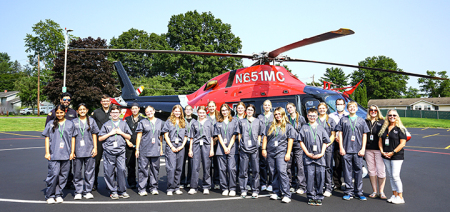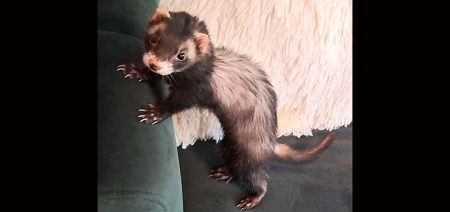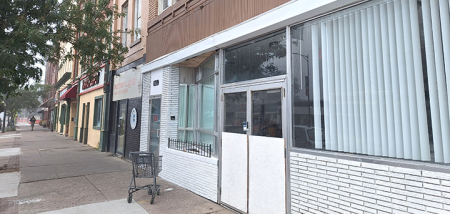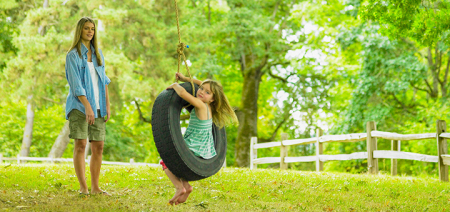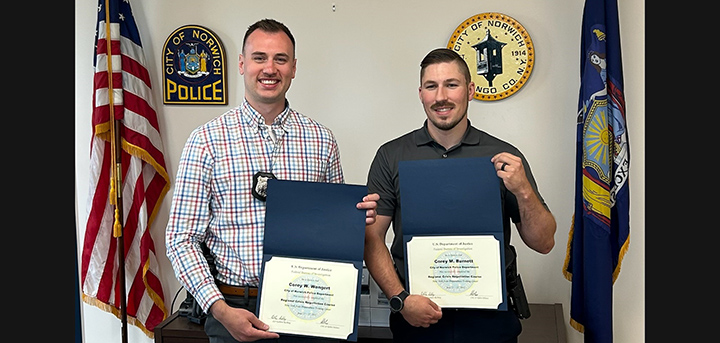Y Giants 11: Starting The 4th Season, 1950
Published:
October 29th, 2007
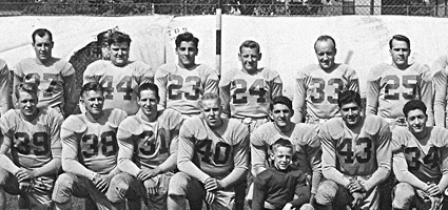
By Jim Dunne
The report that “player shares” were distributed at the banquet at the end of the 1949 season of the Norwich Y Giants is of interest. Up to this point, the players had received no compensation. The total budget for 1949 was a little over $7,000, but only about $300 was spent on uniforms and equipment, whereas this expense in the previous year was over $2,000. (By this time, the team had both green and silver jerseys.) It was decided that about $2,000 could be divided among the players, including a $200 purse for Coach Crittenden, the same as was presented to Coach Lee the year before.
The shares were determined by the Board of Control, and not every player received the same amount. The shares depended upon an amount for “game,” and another amount for “practice.” Twenty-one of 28 players received $40 for the former category, with the other 7 receiving either $27 or $20. The amounts for “practice” varied, and must have been more directly related to participation. The highest total for any one player was $67, which went to 3 men, and the lowest was $31. Certainly no one was playing for the money, but the token was appreciated. The total disbursed as “player shares” was $1,820.
Plans for the 1950 season were announced at a meeting held on August 2, 1950. Not wanting to fix anything that wasn’t broken, the Giants management and coaches stuck to the program that had proved successful in prior years. One related change that was noticeable was in the heading of the Sun’s Sport Slants, where the byline now read, “By Perry Browne and Bob VanTine.” The popular VanTine, NHS ’39, had established himself as a competent replacement for Browne, permitting Browne to advance to the editorship of the Sun. Van also became the volunteer coach for the Y’s youth basketball teams. In subsequent years, he proved to be a positive influence on many of the young men of the 1950s, as he coached basketball (buying uniforms with his own funds) and arranged trips to college and professional games for his young charges. He also served, along with George Echentile, as advisor to the Chenango Boys Hi-Y Club.
Van’s writing style was so similar to Browne’s – probably because he had grown up reading it – that it was difficult to tell who had written what. They both did all they could to augment the coaches’ efforts by providing praise for good results – which, in the case of the Giants, were frequent. However, they could provide negative motivation as well. As Norwich prepared for the first game of the 1950 season, against Sidney on September 17th, having perhaps noticed a lack of something in the early practices, they chose the following quote from Coach Bob Crittenden: “It is difficult to say at this point just how ready we will be for the lid-lifter. I expect a rugged battle, and how far advanced we are in condition is going to provide a lot of the answer.” Sidney was now coached by Jack Lee, the well-respected mentor who had led the Y Giants to stellar seasons in their first two years. Although Norwich was victorious by 7–0, Van (or Perry) put things in perspective: “An unimpressive performance…disappointed the team’s followers. Offensively there was a lack of timing and some poor ball-handling with a woeful lack of blocking. The blocking when it did exist lacked authority. The few bright spots on offense were provided by Bud Seaman and Richie Barnes, a pair of speedsters who turned in several glittering runs.”
The 1950 season brought several roster changes. Dick VanDeusen, a mainstay of the line and a great punter who had made the trip from Allentown every weekend during the season, had graduated from Muhlenburg and gone on to graduate school in Florida. Burt Palmatier, who had been the senior man on the squad for the first three years, finally retired; his leadership would be missed. John Ebovicz, an important part of the backfield in 1949, enlisted in the Navy. Don Barnes went into the service – he and his five brothers and sisters all served in the military. Also missing were Loren VanSteinburg, Ray Clark, and Dick Storrer. To make matters worse, two career-ending injuries occurred early in the season, with halfback Richie Barnes going down in the first game, and fullback Jim Kelly seriously hurt in the third game. Both men were starters.
New men joining the squad were Captain Frank DiNoto, Tony Liberatore, and Frank Rodiquenzi (who played the last three games of the 1949 season), all from the NHS 1949 team. Other additions were George Podenak, John Pierson, Ray Turner from Sherburne, Leonard Quinn from Oxford, and Bud Seaman’s younger brother, Dave. Liberatore started the season at quarterback, his position in high school, but after the injury to Richie Barnes, he shifted to Barnes’s halfback slot, and Don Crittenden, captain of the NHS 1946 team, rejoined the team as quarterback. By 1950, the team ran for the most part out of the T formation, and the two-platoon system was more frequently used.
The second game, on September 24th, found the Giants hosting the team from North Utica, and they showed improved form in administering a 16–6 trouncing. The defense was outstanding, with the only Utica score coming on an interception, and the offense managed the changes imposed by the loss of Richie Barnes well. Norwich touchdowns were scored by John Kelly and Babe Barnes, with Plum Palmer adding the extra points. Buddy Seaman ripped off several long gains. Fred Mirabito was responsible for the other two points, tackling a Utica back in the end zone. Other defensive standouts were George Echentile, Ray Turner, Frank DiNoto, Bob Conron, Frank Rodiquenzi, John Pierson, and the Kelly brothers. Assistant coach Bob Ryan, who handled the linemen and made the line substitutions during the game, had reason to be proud of the improvement of his charges.
The next week brought the Jessup, Pa. Leopards to town. Jessup was unbeaten and the conqueror of that old Norwich nemesis, Endicott North Side Social Club, in its opener. The Giants showed even more improvement in this game, and it was a good thing, as they squeaked by on an extra point and a rare Plum Palmer field goal, 10–6. The other star of the game was George Echentile, the superlativ e defensive end who added an offensive gem with an outstanding catch of a Bob Crittenden aerial for Norwich’s only touchdown. Mike Rotundo, Ray Turner, cousins Frank and Sam DiNoto, Fred Mirabito, and Harold Barnes were also defensive standouts, while Tony Liberatore settled into his new position and ran well enough to take the heat off his mate, Buddy Seaman. The confident Leopards were stunned by the play of Norwich, and did not score until the last play of the game. For the Giants, the permanent loss of Jim Kelly, the good-natured (except when he was blasting into the line), well-liked fullback and charter member of the team, was a tough blow to absorb.
The Syracuse Red Terrors rolled into town on October 8, 1950. Players from the All-Nationals had joined the Terrors when their team folded, and they promised to provide a game like the 14–13 thriller of 1947 between the Giants and the Nats. Although John Kelly, who had missed the Jessup game with an injury, had recovered, he was absent due to “an appointment at the altar” the day before. Fred Mirabito, the starting center (Conron had moved to tackle), was unavailable due to injury, and his spot was filled by Ed Weed. Frank Rodiquenzi assumed the starter’s role at fullback. In addition, two new players joined the squad at this point: Frank Cline, 215-lb. former Hartwick lineman now coaching at Gilbertsville, would be used on defense, and 6’4” Bob Higgie would have the opportunity to catch some passes at end. A close game at half-time, it turned into a rout in the third period as Norwich scored three touchdowns. The hero of the game was diminutive Guilford speedster Buddy Seaman, who crossed the goal line four times with runs of 6, 2, 41 and 74 yards. Everyone who remembers the Giants, players and fans alike, credit Seaman as being the greatest runner to trod what Perry Browne called “the ancient plains” of Alumni Field. He must have loved to play football, and he must have loved to play for the Y Giants, for he drove from his Air Force base in Vermont every weekend in order to play.
Part 12 of this 25-part series will appear in Tuesday’s Evening Sun.
Comments
